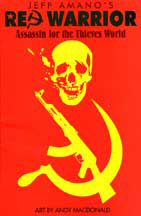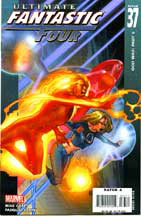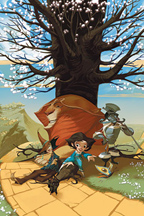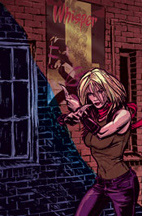A NOTE FROM SEAN…
Here’s a smattering a trades and some other reviews for
your reading pleasure.
For those of you who still read monthly comics and enjoy
the occassional small press or indie book, be sure to check out the
warrior-scribes’ expanded comic book review site RACK RAIDS at www.rackraids.com.
Happy New Year!
Elgin Carver: Red Warrior: Assassin For The Thieves World (Image Comics)
Red Warrior: Assassin For The Thieves World (Image Comics)
The philosophies of life are as varied and inventive as any area of
human thought. One of the least likely must be the concept of "spirituality"
found through the practice of martial arts. In Western popular culture, Bruce
Lee must be given a large portion of the credit for creating any awareness that
this thought thread exists. His physical beauty, grace of movement, and obvious
dedication to his trade gave credence to his stated positions. From his fame
rose general popularity, or at least availability, of Kung-Fu movies made in China
in which this philosophy is given fantastic embodiment. Mental dedication
results in fighters who are able to leap impossible heights and absorb
horrendous physical punishment. Both the good and the bad can create within
themselves great power by dedicated study and practice.
Jeff Amano has created a world wherein a spetnaz (Russian Special Forces) vet
is on the New York police force and faces other ex and present members of that
same military force. What seems to be a cop/spy story suddenly swerves off to
the left with the introduction of mental force projection that kills with the
blink of an eye. Here are people the world would be better off without,
involved in actions difficult to care about. This black and white graphic novel
is reasonably well drawn and moves quickly if confusingly to a somewhat predictable
ending. Amano then tacks on an addenda that attaches the philosophy of martial
arts and his deep seated feelings for the ultimate type of fighting often seen
on television.
What could have been an otherwise entertaining read becomes a tainted adoration
of brutal power. This sort of martial arts love fest, enjoyable in a Bruce Lee
fantasy, an excuse for street thugs to pound each other on television, is used
here to glamorize and raise to a higher level, people the reader would
otherwise avoid. Real warriors fight to protect their family, nation, and
culture. They find it nasty, vicious, and pitiless. If you want to see and hear
about real warriors, take a trip to your local VA hospital. There you will find
men and women who have given their bodies and their minds to the real warrior
code without mind blasts and for actual purpose. You might take a stack of
comics along for them to read while you are at it.

TWO AND A HALF OUT OF FIVE VIKINGS
 Atlas Era Tales Of Suspense
Atlas Era Tales Of Suspense
Volume 1 (Marvel Comics)
Patrons of comics usually
consider them as entertainment, sometimes as art, too often as investments.
Seldom, if ever, are the business aspects of their production given any thought
at all. Yet they are product, created to provide income for the artists and
writers and profit for the owners of the producing companies. (As an aside,
what was the largest comic company that ever existed? DC? No. Marvel? No. Timely,
Quality, Harvey, Dell, Gold Key? No, no, no, no, and no. It was Atlas.) The implosion
of Atlas in the mid to late 1950s, brought on by poor business decisions and
inter-office politics, should be of deep interest to advanced fans as it has
been credited by some for the birth pangs of the modern comic business. There
is truth to that belief, but is a subject too complicated for this review.
However it should be understood that this book is a direct result of those machinations
and its historical position is important because of that fact. The creation of
this title and others from this time period are a cause-and-effect result of
the disintegration of what was a huge operation that devolved into a two man
business, one of which was Stan Lee. In a rebuilding effort Stan put together a
small stable of artists, Jack Kirby, Steve Ditko, Don Heck, Dick Ayers, and
Paul Reinman. If the list seems familiar it is simply because this is the
core of the Marvel Explosion that began in 1961 and created the world of comics
as it exists today.
If you can imagine EC
comics like Shock Suspense Stories, Weird Science, or Weird Fiction made by
Marvel, you can picture this volume. Giant Monsters and aliens abound
with "surprise" endings the norm. What makes this book especially
appealing is the artwork. Kirby has several stories that surely prefigure his
work on the Challengers of the Unknown, and once Ditko hits his stride by issue
# 7 ( the first 10 issues of the title are included in this volume) his art is
as good as any he ever did, and better than most. The reader will also find
good examples of work by Russ Heath, Al Williamson, John Buscema, Carl Burgos,
and Joe Sinnott, along with the other names familiar to Marvel fans. The
stories are representative of the era, loved by some and considered an acquired
taste by others. They are less than deep but more than superficial. In other
words, comic stories from the 50’s. The introduction has an interesting, if
somewhat confusing history of what brought on the creation of this title and is
a good place to begin your study of the Atlas implosion.
This volume is formatted to be compatible with the Marvel Masterworks series in
both size, quality, and price. There is a companion volume, The Atlas Era Tales
To Astonish, of equal interest and importance. These belong on your bookshelf,
in a reasonably prominent position.

FOUR OUT OF FIVE VIKINGS

Ultimate Fantastic Four #33 – 37 (Marvel Comics
When the Fantastic Four appeared, to alter comics forever, they brought with
them several identifying characteristics. Stories that contained personal
travails were and are common. Marriage, bankruptcy, personal enmity and
friendship, and various private problems unknown to the genre previously are
woven throughout. This is the meat and potatoes of the discussions whenever
this book or its history is written of. Equally important but seldom receiving
the analysis deserved is the panoramic and apocalyptic visions that envelope
the team from early in their career. No other characters or group of characters
adventures span the warp and woof of the imaginary universes as does the FF nor
so consistently save the entire planet, if not existence as we understand it.
The re-imagining
of the Marvel Universe in the Ultimate series has, with few exceptions, been
consistently superior. Many previously used stories have been rewritten to
raise the content to a more adult level, not just in language, but in
complexity and outlook. Ultimate Spiderman, a notable success in this updating,
has led the way but this title is rapidly catching up. A generally consistently
superior look to the art has increased the appeal, also with few exceptions. Most
noteworthy in that less than successful list is seen in Ultimate Power. Whatever
photo references Greg Land, who had been doing the FF, is using in that book
need serious expansion. Look in issue # 3 on page 9 and the bottom panel. Is
that woman screaming in terror or joy? Excellent in most other ways,
Lands’ tacked on heads with often inappropriate expressions have always been a
distraction. Pasqual Ferry is a Spanish artist whose work is more generally pleasing.
His addition to this title promised much and much has been delivered. One
additional aspect that is often overlooked by critics is the coloring. Justin
Ponsor has been delivering the goods on this title for an extended period.
Although his palette may seem a little dark , that is quibbling over what is
one of the better jobs being done in the field today.
Envisioned as teenagers,
their powers strengthened, and with their emotions more clearly explained,
their group and individual hubris become more understandable and rational. With
only Sue and Johnny Storm’s father’s dictatorial power and autocratic manner as
a distracting and disappointing part of the story line, the growth of this
title has been more than satisfying as it has progressed. This particular plot brings
that apocalyptic vision portion of the FF’s appeal into the Ultimate FF with a
vengeance. A group of aliens appear in a department store amid chaos and
destruction. Their communications and intent are difficult to understand. They
attack the FF until circumstances bring on the need to unite and defend
themselves in either another dimension or far distant space. Then Thanos and
Ronan the Accuser appear and things go downhill fast. Herein lies the true
weakness of the 25 or so page comic format. What has taken a short paragraph to
summarize, has been divided over almost half a year. The division of the story
and the waiting time between issues completely destroy the flow. If the title
is not fairing well sales-wise, Or more importantly if new potential comic fans
never expose themselves to the medium there could be little doubt that this is
the cause. Until comics find a way to step beyond this limitation, on a
consistent basis, comics will continue their slow decline into obscurity. Only
an already dedicated fan will go to the trouble to follow such limiting and
distracting a format. Growth of the genre requires another arrangement.
Thanos and his love affair with death are more reasonably written, and believable
than in the past, and, so far at least, we have been spared the physical
personification of death. Powerful and merciless, his abilities have been
expanded and woven into a cultural whole in the society he controls. His
minions and cohorts are consistent in their vicious determination and devotion
to their master. Ronan the accuser appears to deliver judgement and the fate of
Earth hangs in the balance, to coin a phrase. Will the FF prevail? There can be
little doubt but how and when keeps the reader on edge as few other Marvel
books have of late. The next issue should tie this up. If you haven’t read this
title before or lately, you owe yourself some goodness. Pick up these issues
and wait with little patience for the next.

FOUR AND A HALF OUT OF FIVE VIKINGS
Jeb Del: Batman and the Monster Men (DC Comics)
Batman and the Monster Men (DC Comics)
Innocent (usually) men, transformed through the malign whims
of science into misshapen freaks, driven by pain, anger, and bloodlust… they
were a great staple of the pulp era. The Monster Men was arguably the
best novel Edgar Rice Burroughs ever wrote that didn’t involve Tarzan or John
Carter. In The Monsters, Lester Dent gave Doc Savage a similar set of
foes that even the Man of Bronze was hard put to dispatch. With this new
adventure for The Dark Knight, artist-writer Matt Wagner is tipping his hat to
his predecessors, and the results are great, pulpy fun.
Wagner (best known for Grendel) has taken on Batman
in the past, most recently in 2004’s Trinity, which posited the first
meeting of Batman, Superman, and Wonder Woman. I have no idea whether his
version of that initial encounter was, or remains, “canon”—what I do know is
that it was one of the most flat-out entertaining adventures that any of those
characters had been involved with in many years, and a highly recommended trade
collection.
Now, Wagner has started a new series of Batman adventures,
told in 4-issue miniseries. Batman and the Monster Men is the first of
them to be collected in trade paperback form.
We’re a little over a year into The Batman’s career in
Gotham City. Much that will shape our view of the character has yet to come
(there’s no Robin, and the Batmobile is in its final stages of
completion). Names that will become
familiar to Bat fans in years to come (Hugo Strange, Carmine Falcone, Julie
Madison) populate the story, and as was the case with Trinity, Wagner makes all
the pieces fit together in a manner that never feels obtrusive, or as if he
were trying to rewrite Bat-history. I’m sure astute readers could spot places
where he’s stitched things together, but for most comic readers, he uses
Batman’s rich lore to create a timeless version of the character.
Professor Hugo Strange, not yet quite a “mad scientist” (but
teetering on the edge) has made some bad connections in his attempts to fund
his bizarre medical research. Also in deep to the mob is businessman Norman
Madison, which is complicating his daughter Julie’s budding romance with Bruce
Wayne. Strange’s desperation sets bloody events into motion, and Batman is soon
challenged on two sides, by Strange’s monstrous creations, as well as his
girlfriend’s father’s involvement with the mob.
As he demonstrated in Trinity, Wagner has an
excellent grasp of story structure, and even though this series was originally
released as four issues, the story unfolds in a nice three-act arc, reminiscent
less of modern comics writing than a good action movie or mystery novel—and
action and mystery are both elements that this story delivers big-time. It’s
pretty rare for a comic to give us a sense that Batman’s truly in over his
head—too many writers make him impossibly smug and ridiculously over-prepared.
Wagner plays on Batman’s inexperience at this point in his career to make his
eventual meeting with the Monster Men as gripping a fight as I’ve seen Batman
get into in many years.
Not to slight the artwork in favor of the story– Wagner’s
Gotham City, like Tim Burton’s, has a nicely non-specific period look to it.
The fact that he sets so much of the story in the corridors of power (elegant
society parties, a mobster’s palatial mansion) allows him to dress most of the
male characters in generic suits and tuxes, but then give Julie a
Jackie-Kennedy-style pillbox hat without making it feel out of place. Wagner’s
Batman is a stripped-down second cousin of the Superman from the Fleischer
cartoons—imposing and powerful, but even more human and vulnerable.
With the avalanche of Batman trade paperbacks on the
shelves, it can be hard to decide where to start reading once you’re through
with Frank Miller. Just look for Matt Wagner’s name—he’s got the character
nailed down.

FOUR OUT OF FIVE VIKINGS
Graig Kent:
 The Trouble With Girls, VOL. 1 (Checker BPG)
The Trouble With Girls, VOL. 1 (Checker BPG)
The concept of the super-spy didn’t really
take off until the Cold War did, and it’s been love and fascination with them
ever since. From James Bond, John Steed
and Emma Peel, to modern day’s Jason Bourne and Mr. and Mrs. Smith, we love and
spend a lot of money on loving the super-spy.
At the same time, the super-spy spoof has been just as prevalent,
Maxwell Smart really forged the way, Danger Mouse and Inspector Gadget skewed
spies for kids, while Austin Powers has pretty much had the last word on
swingin’ sixties over-the-top espionage parodies, in fact Mike Meyers’
gnarly-toothed creation was so permeating in popular culture, that the last few
Brosnan James Bond films seemed unintentionally self-satirical.
But before Austin Powers there was Lester
Girls, the super-spy who can do no wrong, with a heart of gold and every man
and woman’s desire. The only problem is,
Lester wants nothing to do with his high-octane, high-adventure lifestyle. All he’s ever wanted was to escape the
trappings of his good looks, money and fame and settle down with a nice, plain
girl and live in suburbia with 2.74 kids, a dog (that won’t get fed poisoned
steaks by stealthy ninjas), 2 car garage and a white picket fence. But action, adventure and sex seem to follow
Lester wherever he goes, no matter how careful he is. And that’s the running joke of the Trouble
With Girls.
Once you get the punchline, there’s not
much else you need to grasp a handle on, Lester’s personality is really as
simple as he wants to be, it’s just that his life that’s complicated. Written and created by Will Jacobs and Gerard
Jones back in 1987 and published by Malibu Comics over the span of six years, Girls
is a low-dosage high-adventure soft-spirited comedy. Reading too many issues at once (as one tends
to do with collected editions) exposes the inherent one-note-joke that the
series contains. Jacobs and Jones both
have a goofy National Lampoon sensibility about them, so Girls feels
like something out of a 1980’s college-fraternity newspaper. Tim Hamilton’s artwork is untrained and
choppy, faces distort into different proportions from panel to panel, but his
comedic timing works with the story, and improvement can be noticed from one
issue to the next.
It’s about 20 years out of date in style,
tone and humour, so this collection really serves more as archived curiosity
rather than essential reading. It’s not
offensive, but it lacks the charm of the popular straight-edged super-spies and
the successful parodies that mock them.

TWO AND A HALF OUT OF FIVE VIKINGS
 The Wonderful Wizard of Oz (Image Comics)
The Wonderful Wizard of Oz (Image Comics)
I have a copy of the Annotated version of
L. Frank Baum’s Wizard of Oz on my bookshelf, where it’s sat for a
handful of years now, untouched. It’s
true, I havn’t actually read the book before.
Like many of us, I’ve only had dozens of viewings of the classic Judy
Garland version (and the underrated mid-‘80’s sequel, the Return to Oz)
to relate to. So reading this new
adaptation by the French team of writer David Chauvel and artist Enrique
Fernandez was a bit of a shock; I had no idea that’s how the story really went.
My ignorance fully disclosed, I must admit
that The Wonderful Wizard of Oz, as presented here, is utterly
captivating. In part I think it’s the
comparison between the movie and the adaptation, but moreover because it’s just
a really good story. Baum set out to
create an adventurous story for children, one that differed greatly from Aesop
or Grimm fables of the past, something that featured more adventure and more
modern sensibilities but without losing the morality play that back the best
children’s stories. With Oz, he
certainly succeeded, and the book and its derivatives have been entertaining
the masses for decades.
I don’t know if Chauvel has embellished Baum’s
text much, but this iteration of the story, as compared to the film, seems to
have greater elements of fantasy. In
relating the origins of the Tin Man and the Scarecrow, alongside the Witches
and the Wizard himself, there’s so much more magic and wonder involved than the
film ever captured. The film seems
almost innocently naive in comparison.
Fernandez’ art is stunning in every respect, like cel animation, but
intended to be still works of art. This
is a vibrantly colored, imaginatively illustrated, and thoughtfully conceived,
eliminating almost every trace of the film everyone knows.
The story may be a bit more severe for a
really young audience, but it’s such an open and welcoming volume it could be
universally enjoyable.

FOUR AND A HALF OUT OF FIVE VIKINGS
 Whisper One-Shot (Boom Studios)
Whisper One-Shot (Boom Studios)
Stephen Grant’s Whisper is
resurrected once again in this 24-page one-off from Boom Studios. Whisper was originally published
through First Comics in the 1980’s, and was last seen well over a decade
ago. As well travelled as I am in
comics, I can’t say I’ve ever read the series before and my familiarity with
the character is nil, and no doubt I’m in the majority. This one-shot, therefore, works at catering
to both the newcomers like myself, and the old fans, long hanging onto hope of
the character’s return.
Having created the character, a female
mercenary by trade, Grant imbues an intangible affection into the character
that lifts this somewhat middling character into a whole that’s more than her
parts. The opening sequence is
disorienting but serves as both metaphor and flashback, it’s relevance revealed
at the book’s finish. Though long-time
fans may grumble, this new Whisper isn’t exactly the same as the one that
preceded her, but Grant does logically bridge the fractions in a satisfying
manner that sheds just enough information on the happenings of the old series
without dwelling in it. This comic,
thought done-in-one, is forward-looking.
Don’t be too surprised if there’s another mini-series of ongoing on the
horizon.
The art by Jean Dzialowski is sketchy, with an unpolished feel, but it works
well with the grittiness of the story.
His pencils seem uninked (or digitally done with a softer finish), while
Sunder Raj’s colors have the texture of pastel further defining a specific feel
to the book. In all, depending on your
perspective, a nice introduction or a nice conclusion… perhaps both.

THREE AND A HALF OUT OF FIVE VIKINGS
Discuss this column on our message boards here.